
CALCITE
Specimen cal-57
$ 105.00
Dims: 6.0" x 4.5" x 4.5" (15.2 x 11.4 x 11.4 cm)
Wt: 3 lbs., 0.7 oz. (1.381 kg)
Amax Mine, Reynolds County, Missouri, U.S.A.
This rather complex specimen consists of nearly twenty small scalenohedral "dogtooth" Calcite crystals on a rather unusual host rock. The crystals range from 0.2 - 0.8" (0.5 - 2.0 cm) in length, with the largest ones occurring in the form of base-to-base contact twins. All have excellent crystal form, and the specimen as a whole shows almost no damage. These crystals have a pale yellow coloration and a vitreous luster, and are transparent and quite clear, though the twinning plane in the twinned crystals tends to be foggy. These crystals rest on a very strangely-shaped dolomitic limestone host rock; it almost reminds me of a coral that one would find in the ocean. It is covered with very small (2 mm diameter, maximum) white dolomite rhombohedrons that are rather heavily dusted with tiny spearhead marcasite and tetrahedral chalcopyrite crystals, which do not exceed 4 mm in diameter or length. I really like specimens like this one; it has many crevices and a lot of material to examine.
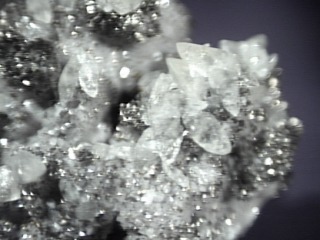
 Amethyst Galleries' Mineral Gallery MINERALS |

$ 600.00
Dims: 15" x 6-3/4" x 4-3/4"
Wt: 30 lbs
1100 foot level, Brushy Creek Mine, Reynolds Co., Missouri, U.S.A.
This is it: the largest and highest quality specimen of the Brushy Creek Mine Calcite that I've seen, and it kicks some serious mineralogical heinee! (how the heck do you spell that word?) It is rife with phantom calcite, twins, and the most colorful Marcasite of our selection. Easily a museum-quality piece, one had better have a good bit of spotlighted space to do it justice. The crystals range in length from 1/2 inch to 7 inches, and have some truly bizarre forms.

1100 foot level, Brushy Creek Mine, Reynolds Co., Missouri, U.S.A.
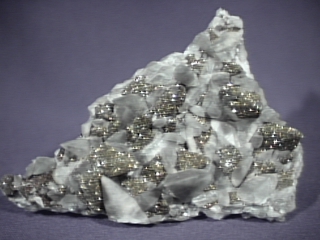
CALCITE specimen cal-36
$ 93.00
$ 93.00
Dims: 5.0" x 3.8" x 1.4" (12.7 x 9.6 x 3.6 cm)
Wt: 7.30 oz. (207.1 g)
1100 foot level, 106 Drift, Brushy Creek Mine, Reynolds County, Missouri, U.S.A.
This specimen is basically a triangular section of a crust which is made up of intergrown Calcite scalenohedrons. They range in length from 0.1 - 1.1" (0.3 - 2.8 cm) and have excellent form. Less than half of the crystals are covered with a crust made up of tiny marcasite crystals that are dull red, green, and gold in color. The uncovered ones have a pearly luster and dim transparence. Phantoms made of layers of microscopic marcasite crystals give them a gray coloration, whereas deeper phantoms have the visible sparkle of larger marcasites. The Calcites are aligned at random angles, and damage is limited to the crystals on the immediate edge of the crust.
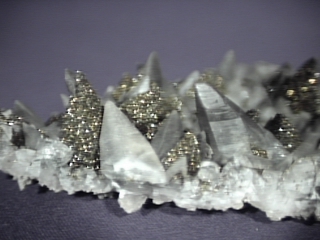

cal-36 ($ 93.00)
1100 foot level, 106 Drift, Brushy Creek Mine, Reynolds County, Missouri, U.S.A.

CALCITE specimen cal-38
$ 320.00
$ 320.00
Dims: 8.4" x 6.0" x 5.6" (21.3 x 15.2 x 14.2 cm)
Wt: 3 lbs., 2.0 oz. (1.417 kg)
1100 foot level, 106 Drift, Brushy Creek Mine, Reynolds County, Missouri, U.S.A.
A magnificent specimen, this piece is composed of dozens of scalenohedral Calcite crystals that are intergrown, forming a crust. They have excellent form, and damage is noticeable but mostly limited to crystals on the edges of the piece. All the crystals but one range from 0.1 - 1.8" (0.3 - 4.6 cm) in length. The largest crystal far exceeds that, with dimensions of 5.0 x 3.2 x 2.0" (12.7 x 8.1 x 5.1 cm); it stands nearly straight up, towering over the rest of the crust. A few of the crystals scattered in the crust are coated with a thin crust made up of tiny, colorful marcasite crystals which make them sparkle. Most, however, are not, and have a pearly luster and are faintly translucent. They contain phantoms< that are made of layers of microscopic marcasite crystals, which give the Calcites a gray color.


cal-38 ($320.00)
1100 foot level, 106 Drift, Brushy Creek Mine, Reynolds County, Missouri, U.S.A.

CALCITE specimen cal-42
$ 30.00
$ 30.00
Dims: 2.7" x 2.7" x 1.2" (6.9 x 6.9 x 3.0 cm)
Wt: 3.75 oz. (106.4 g)
1100 foot level, 106 Drift, Brushy Creek Mine, Reynolds County, Missouri, U.S.A.
A few intergrown, misshapen Calcite crystals make up this specimen from the American midwest. They are in the form of scalenohedrons, and the two largest crystals form a base-to-base twin that has dimensions of 2.7 x 1.2 x 1.0" (6.9 x 3.0 x 2.5 cm). They have little visible damage, though one crystal is cleaved cleanly off of the base of another, where it had formed another base-to-base twin. Their form is good, though misshapen, with well-defined edges and faces that show heavy growth-related striations and a pearly luster. The crystals are dimly transparent and have a dull yellow coloration, but appear gray due to subtle phantoming that occurs just below each one's surface. These phantoms consist of layers of microscopic marcasite crystals. There are some much larger, exposed marcasites on the specimen's edge that are colored red and blue, with their standard metallic luster.

cal-42 ($ 30.00)
1100 foot level, 106 Drift, Brushy Creek Mine, Reynolds County, Missouri, U.S.A.

CALCITE specimen cal-46
$ 37.00
$ 37.00
Dims: 2.9" x 2.0" x 1.1" (7.4 x 5.1 x 2.8 cm)
Wt: 2.91 oz. (82.7 g)
1100 foot level, 106 Drift, Brushy Creek Mine, Reynolds County, Missouri, U.S.A.
At least 20 Calcite scalenohedrons make up this specimen. They have excellent form, and damage is confined to a few areas on the edge of the crust on which they rest. The largest of these crystals measures approximately 1.2" (3.0 cm) in length; it and several others on the crust have a gray color and a pearly luster, and are dimly transparent. This transparence enables one to see subtle phantoms that are trapped just beneath their surfaces. The phantoms are made up of layers of microscopic marcasite crystals, and give the Calcites their color. The rest of the crystals on the specimen are coated with crusts of more, larger (but still extremely small) marcasite crystals, giving them a multicolored sparkle. The crystals are aligned in random directions and are intergrown, forming the crust from which they rise.

cal-46 ($ 37.00)
1100 foot level, 106 Drift, Brushy Creek Mine, Reynolds County, Missouri, U.S.A.

CALCITE specimen cal-49
$ 38.00
$ 38.00
Dims: 2.7" x 2.0" x 1.4" (6.9 x 5.1 x 3.6 cm)
Wt: 2.46 oz. (69.7 g)
1100 foot level, 106 Drift, Brushy Creek Mine, Reynolds County, Missouri, U.S.A.
Another specimen from Missouri in the U.S., this piece consists of several scalenohedral Calcites that have excellent form. One tip of one crystal is damaged, but that is all that I can see. The largest of these crystals measures approximately 1.6" (41. cm) in length. Most of the crystals have a gray coloration (caused by phantoms just below their surfaces), pearly luster, and dim transparence. Their transparence enables one to see phantoms deep inside some of the crystals that are made up of layers of small marcasite crystals. One crystal, however, shows a coating of tiny, colorful marcasites on its surface, but it is partially obscured by a gray Calcite that is growing off of and parallel to it. Other than that, all the crystals are aligned at random angles and are intergrown to form the crust that constitutes the specimen.

cal-49 ($ 38.00)
1100 foot level, 106 Drift, Brushy Creek Mine, Reynolds County, Missouri, U.S.A.

$ 105.00
Dims: 6.0" x 4.5" x 4.5" (15.2 x 11.4 x 11.4 cm)
Wt: 3 lbs., 0.7 oz. (1.381 kg)
Amax Mine, Reynolds County, Missouri, U.S.A.
This rather complex specimen consists of nearly twenty small scalenohedral "dogtooth" Calcite crystals on a rather unusual host rock. The crystals range from 0.2 - 0.8" (0.5 - 2.0 cm) in length, with the largest ones occurring in the form of base-to-base contact twins. All have excellent crystal form, and the specimen as a whole shows almost no damage. These crystals have a pale yellow coloration and a vitreous luster, and are transparent and quite clear, though the twinning plane in the twinned crystals tends to be foggy. These crystals rest on a very strangely-shaped dolomitic limestone host rock; it almost reminds me of a coral that one would find in the ocean. It is covered with very small (2 mm diameter, maximum) white dolomite rhombohedrons that are rather heavily dusted with tiny spearhead marcasite and tetrahedral chalcopyrite crystals, which do not exceed 4 mm in diameter or length. I really like specimens like this one; it has many crevices and a lot of material to examine.


Amax Mine, Reynolds County, Missouri, U.S.A.

CALCITE specimen cal-69
$ 60.00
$ 60.00
Dims: 3.7" x 1.8" x 1.2" (9.4 x 4.6 x 3.0 cm)
Wt: 2.49 oz. (70.6 g)
1100 foot level, 106 drift, Brushy Creek Mine, Reynolds County, Missouri, U.S.A.
This Brushy Creek specimen consists of a crust made up of several scalenohedral "dogtooth" Calcite crystals that have excellent form and show very little damage. The largest of these crystals measures 1.3 x 0.8 x 0.5" (3.3 x 2.0 x 1.3 cm), and like several others, has smooth, clean faces (that show a bright, pearly luster), well-defined edges, and a gray coloration that is caused by phantom inclusions of tiny marcasite crystals. Other crystals in the cluster, however, are covered with larger marcasite crystals that sparkle with a metallic luster and show subtle tinges of red, yellow, and green iridescence. As far as we know, the Brushy Creek locality in the midwestern U.S. is the only locality where material of this type is found.

cal-69 ($ 60.00)
1100 foot level, 106 drift, Brushy Creek Mine, Reynolds County, Missouri, U.S.A.
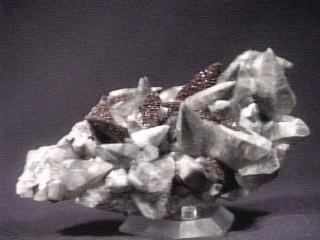
CALCITE specimen cal-74
$ 55.00
$ 55.00
Dims: 4.2" x 2.1" x 1.4" (10.7 x 5.3 x 3.6 cm)
Wt: 5.34 oz. (151.5 g)
1100 foot level, 106 drift, Brushy Creek Mine, Reynolds County, Missouri, U.S.A.
This specimen consists of a crust that is made up of many intergrown scalenohedral "dogtooth" Calcite crystals that are intergrown, mostly at their bases. The cluster is in generally good condition, though there are a few areas of obvious cleavage damage. The largest of the crystals on this cluster measure not more than 1" (2.5 cm) in length. Most of these crystals have clean faces and edges that have a pearly luster and are colored gray due to the presence of microscopic marcasite crystals that are included within. However, some of the Calcites have visible marcasite crystals coating their exteriors, giving them a reddish-to-gold coloration and a metallic sparkle.

cal-74 ($ 55.00)
1100 foot level, 106 drift, Brushy Creek Mine, Reynolds County, Missouri, U.S.A.
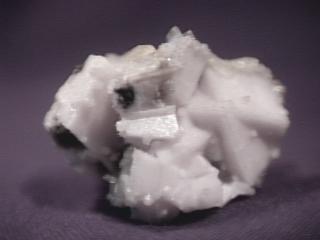
CALCITE specimen cal-77
$ 25.00
$ 25.00
Dims: 1.7" x 1.6" x 1.1" (4.3 x 4.1 x 2.8 cm)
Wt: 1.89 oz. (53.7 g)
Naica, Chihuahua, Mexico
A bit of a mystery surrounds this specimen. It consists of a cluster that is made up predominantly of Calcite. The Calcite occurs in the form of rhombohedrons that range in size from 1 mm to 0.5" (1.3 cm) along an edge. Their color is a bright white and their luster is pearly, which makes me think that maybe these are actually crystals of ankerite, as there are also many tiny clusters of "dogtooth" Calcites scattered on parts of some of the large crystals. That is not the mystery, though. Among these large crystals, the tiny "dogtooth" crystals, and many small disphenoidal chalcopyrites that are scattered about, are some thin, bladed crystals that I cannot identify. They have what appears to be a monoclinic form, a pale beige color and a vitreous luster, and are transparent and very clear. They show no effervescence in a dilute acid, and seem to be harder than Calcite. I thought they might be siderites at first, but the form is wrong. I really am at a loss as to what they are.


cal-77 ($ 25.00)
Naica, Chihuahua, Mexico

CALCITE specimen cal-79
$ 45.00
$ 45.00
Dims: 3.4" x 3.3" x 2.3" (8.6 x 8.4 x 5.8 cm)
Wt: 15.3 oz. (434 g)
Pachapaque Mine, Ancash, Peru
This specimen contains an example of Calcite that I consider to be very pretty. The gray host rock acts as the base for many small, irregular rounded blades of Calcite. They are in very good condition, showing little human-induced damage, and do not exceed dimensions of 1.0 x 0.1" (2.5 x 0.3 cm). These blades have a bright, white coloration, are opaque, and have a dull, matte luster. Their surfaces are rough and porous-looking, and remind me very much of certain types of coral that I have seen. Actually, their similarity to coral is intense! One can tell, however, that the platelet form in which they occur has a hexagonal shape. It is possible that these platelets underwent considerable weathering or water-wear. Accompanying and often erupting through the platelets are scores of colorless, transparent prismatic quartz crystals that have good form and a surprisingly dull, waxy luster that supports my theory of weathering. There are also what appear to be many tiny pyrite crystals scattered about the piece, though their coloration is very silvery and their form does not look quite cubic- they might possibly have a high concentration of arsenic. The gray host rock on which all of this rests seems to be made up of a combination of massive Calcite and quartz.
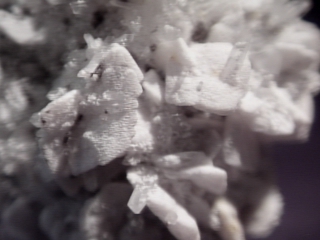

cal-79 ($ 45.00)
Pachapaque Mine, Ancash, Peru

$ 350.00
Dims: 8.3" x 6.4" x 5.2" (21.1 x 16.3 x 13.2 cm)
Wt: 12.7 lbs. (5.8 kg)
Elmwood Mine, Carthage, Smith County, Tennessee, U.S.A.
A very large, cabinet-sized specimen, this Calcite piece is in the form that I like to call a "parallel association", wherein a group of crystals are intergrown parallel to each other, so that it one cannot call it a single crystal, nor could one call it a cluster, accurately. The association is made up of what appears to be three main crystals that have many smaller terminaions at their ends. Nonetheless, their double-terminated scalenohedral crystal form is still evident, and their form is excellent. There is substantial damage in the form of cleavage planes on three areas of the specimen, including one of the main terminations of the second-largest crystal. All of the Calcites have a beautiful golden coloration that intensifies towards their termination tips. All of the crystals are also translucent and quite cloudy at the twinning plane, and increase in clarity towards the terminations, though they never become totally clear. Their faces are clean and smooth and their terminations are well-defined, accenting the crystals' vitreous-to-pearly luster. The association is partially held together by a small amount of a gray dolomitic limestone host rock. On this host rock are several deep-brown sphalerite crystals that have a complex cube-based form and a wonderful adamantine luster. Their color is so deep that they are only dimly translucent at best, and with their luster, appear opaque. They tend to show considerable damage, as most of the visible crystals are quite exposed.
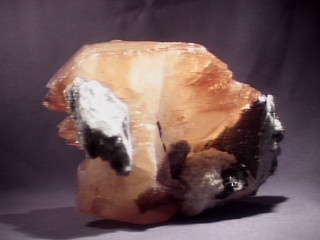

Elmwood Mine, Carthage, Smith County, Tennessee, U.S.A.

CALCITE specimen cal-90
$ 25.00
$ 25.00
Dims: 4.7 x 3.6 x 1.9" (11.9 x 9.1 x 4.8 cm)
Wt: 12.8 oz. (363 g)
unknown
At least 20 Calcite crystals rest on the shale host rock of this hand specimen. These crystals reach maximum dimensions of 0.6 x 0.5 x 0.4" (1.5 x 1.3 x 1.0 cm) and are generally in very good condition, as only a few spots of damage are visible- one of these is rather severe, however. They have excellent trigonal "nailhead" form, though some of them are rather warped and others are more prismatic than tabular in nature. Most of them have a pale, rust-red coloration and are transparent and dimly to moderately clear. I think, though, that the rust coloration is caused by a thin coating over the crystals; light reflected off of their faces (which possess a pearl luster) shows iridescent red, orange, and yellow colors (see the close-up image). These crystals rest on a base of what appears to be dull brown, opaque calcite or aragonite that has an irregular, warped form. This base in turn rests on a thin crust of greenish-gray shale. I have been told that such specimens likely come from India, but the shale base makes me doubtful.


cal-90 ($ 25.00)
unknown
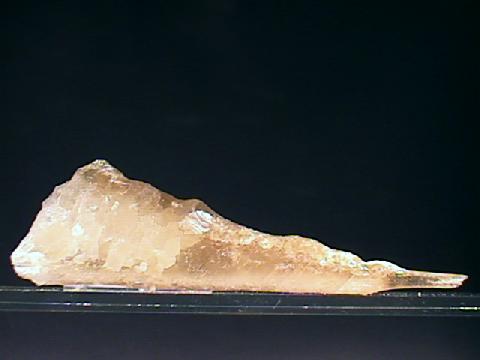
CALCITE specimen cal-101
$ 30.00
$ 30.00
Dims: 5.8 x 2.0 x 0.7" (14.7 x 5.1 x 1.8 cm)
Wt: 3.46 oz. (98.3 g)
unknown (likely Mexico)
This interesting specimen consists of a Calcite stalactite. It appears to be in excellent condition, though its termination tip seems to be cleaved. Even with its stalactitic form, it shows definite crystalline tendencies and even some incomplete crystal form in a few places. It has a moderate golden-brown coloration and an almost silky luster, and is mostly translucent, though its tip shows moderate transparence. There is no base or host rock present.

cal-101 ($ 30.00)
unknown (likely Mexico)

CALCITE specimen cal-105
$ 30.00
$ 30.00
Dims: 5.6 x 5.4 x 3.6" (14.2 x 13.7 x 9.1 cm)
Wt: 4 lbs., 8.0 oz. (2.042 kg)
unknown (likely Chihuahua, Mexico)
This large piece consists of a chunk of a semi-crystalline Calcite crust. It shows definite crystalline tendencies, but is also layered in areas, like marble. Its color ranges from a pale, creamy-yellow to rust-red to nearly colorless, and its uniform pearly luster was likely induced by "pickling" the piece in acid.

cal-105 ($ 30.00)
unknown (likely Chihuahua, Mexico)

CALCITE specimen cal-109
$ 60.00
$ 60.00
Dims: 11.8 x 8.0 x 2.4" (30.0 x 20.3 x 6.1 cm)
Wt: 4 lbs., 15.2 oz. (2.245 kg)
Minas Gerais, Brazil
Countless minute, tabular Calcite crystals form a large crust that covers the host rock of this large cabinet specimen. They are in surprisingly good condition- very few are visibly damaged- and generally do not exceed 0.1" (3 mm) in diameter or thickness. There are a few larger, prismatic crystals, but these are heavily intergrown with the crust and do not exceed 0.4" (1 cm) in length or diameter. All have good trigonal form with shallow pyramidal terminations. They are generally colorless and transparent, though some of the larger crystals show a milky translucence. All have a pearly luster. This crust coats a thin crust of heavily-intergrown, crysatalline quartz that in turn coats a layer of green host rock.


cal-109 ($ 60.00)
Minas Gerais, Brazil

CALCITE specimen cal-110
$ 50.00
$ 50.00
Dims: 9.9 x 5.3 x 2.9" (25.1 x 13.3 x 7.5 cm)
Wt: 5.7 lbs. (2.6 kg)
Minas Gerais, Brazil
Several large, tabular Calcites rest on the basalt base of this large cabinet specimen. They are in moderately good condition, showing considerable damage, and reach 2.8" (7 cm) in diameter. Their trigonal tabular form is highly disseminated, as if each large crystal were made up of scores of smaller, intergrown crystals that are perfectly aligned with each other. All are milky-white in color and translucent and have a pearly luster. The basalt base is coated with a thin, botryidal layer of drusy quartz, upon which the Calcites rest. A layer of the Calcite extends partway through the basalt.


cal-110 ($ 50.00)
Minas Gerais, Brazil
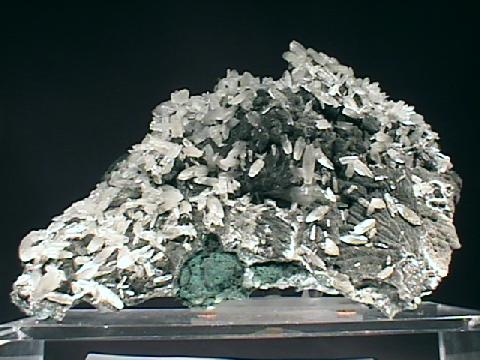
CALCITE specimen cal-116
$ 54.00
$ 54.00
Dims: 8.5 x 5.1 x 2.9" (21.6 x 13.0 x 7.4 cm)
Wt: 2 lbs., 1.7 oz. (954 g)
Minas Gerais, Brazil
Scores of small Calcite prisms rest on the quartz/lava base of this large cabinet specimen. These crystals generally do not exceed 1" (2.5 cm) and are in good condition, though several are cleaved and not complete. Their slim, trigonal "dogtooth" form is good, though most are at least partly intergrown with others. All are nearly milky-white in color and have a dull pearly-to-waxy luster, and most are dimly transparent. They rest on a base that is made up of alternating layers of crystalline quartz and green lava rock.


cal-116 ($ 54.00)
Minas Gerais, Brazil

CALCITE specimen cal-117
$ 150.00
$ 150.00
Dims: 8.5 x 5.6 x 1.7" (21.6 x 14.1 x 4.4 cm)
Wt: 4 lbs., 0.8 oz. (1.837 kg)
Sterling Hill Mine, Ogdensburg, New Jersey, U.S.A.
This flat cabinet specimen is made mostly of massive, white Calcite. The Calcite shows no definite crystal form and actually has a creamy coloration. It serves as the matrix for several spots of willemite and one straight vein that runs completely through the piece. The willemite does appear to be crystalline to a degree and has a color that ranges from a reddish-brown to a pale, rusty orange. When bathed under shortwave UV light, however, the calcite glows a slightly dim, orange color and the willemite glows bright green. When the UV light is suddenly switched off, the willemite phosphoresces - this means that the willemite continues to glow green for a while after the UV radiation is removed.


cal-117 ($150.00)
Sterling Hill Mine, Ogdensburg, New Jersey, U.S.A.

CALCITE specimen cal-119
$ 39.00
$ 39.00
Dims: 4.2 x 3.1 x 1.0" (10.6 x 7.9 x 2.5 cm)
Wt: 7.4 oz. (209 g)
Winfield, Pennsylvania, U.S.A.
This flat hand specimen consists of a Calcite druse that partly covers a shale base. The druse is made up of many crystals that do not exceed 3 mm in diameter. They are in good condition and well-formed, and show a dull, creamy coloration and dim transparence. They are accompanied in places by several clusters of white, radiating strontianite needles. These needles do not exceed 0.4" (1.0 cm) in length and are in good condition where they are protected by hollows and overhangs. When viewed under either long- or shortwave UV light, the Calcite glows a with a dull yellow coloration and the strontianite glows with a white color.


cal-119 ($ 39.00)
Winfield, Pennsylvania, U.S.A.

CALCITE specimen cal-120
$ 39.00
$ 39.00
Dims: 3.7 x 2.8 x 1.5" (9.5 x 7.1 x 3.9 cm)
Wt: 8.2 oz. (232 g)
Winfield, Pennsylvania, U.S.A.
A vein of crystalline Calcite runs through the shale host rock of this piece. The crystals do not exceed 0.1" (3 mm) but appear to be well-formed. Though most of the exposed ones are damaged, many are protected in hollows. All have a dull, cream coloration and are dimly transparent. A few clusters of radiating strontianite needles are also present. When viewed under UV light, the Calcite glows with a dull yellow color and the strontianite shows up as a brighter white.


cal-120 ($ 39.00)
Winfield, Pennsylvania, U.S.A.

CALCITE specimen cal-122
$ 80.00
$ 80.00
Dims: 4.1 x 2.5 x 1.4" (10.5 x 6.4 x 3.6 cm)
Wt: 4.98 oz. (141.3 g)
1100-foot level, 106 drift, Brushy Creek Mine, Reynolds County, Missouri, U.S.A.
This hand specimen consists of a cluster of partly-intergrown "dogtooth" Calcites. These crystals are in excellent condition, showing almost no damage, and reach nearly 1.5" (3.8 cm) in length. All have excellent trigonal form. Most are coated with a thin druse of tiny marcasite crystals, giving them a dull golden color and a metallic sparkle, but some are uncovered and have a gray color due to included marcasite and a dull pearly luster. There is no host rock present.


cal-122 ($ 80.00)
1100-foot level, 106 drift, Brushy Creek Mine, Reynolds County, Missouri, U.S.A.
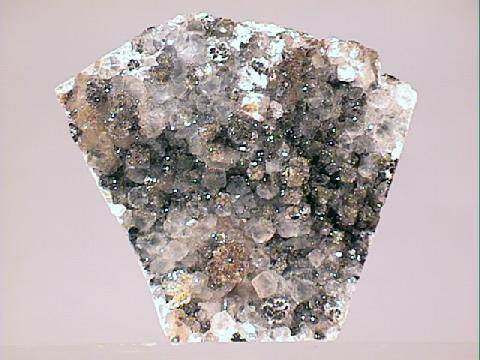
CALCITE specimen cal-126
$ 26.00
$ 26.00
Dims: 1.6 x 1.5 x 0.4" (4.1 x 3.8 x 1.0 cm)
Wt: 19.0 g
not yet determined
This piece is more of a jewelry piece than a collector piece, I think, and was originally sold as "drusy quartz". While there is some quartz in it, most of the larger crystals are made up of flat, "nail-head" Calcites that are generally in good condition- there are a few spots of obvious damage, however. The Calcites are colorless, moderately transparent, and show a pearly luster. Their trigonal form is quite good, considering their intergrowth. They rest among what appear to be several rounded formations of drusy quartz. The sparse base rock is cut flat and ground smooth.

cal-126 ($ 26.00)
not yet determined

CALCITE specimen cal-130
$ 65.00
$ 65.00
Dims: 5.0 x 2.0 x 1.0" (12.8 x 5.0 x 2.6 cm)
Wt: 2.95 oz. (83.9 g)
1100 foot level, 106 drift, Brushy Creek Mine, Reynolds County, Missouri, U.S.A.
A cluster of well-formed Calcite prisms makes up this small cabinet specimen. These crystals do not exceed 1.0" (2.5 cm) in length and show excellent trigonal form and little damage. Some of them are covered with a thin layer of marcasite, giving them a metallic sparkle. Others are not covered, and have a gray color due to phantom layers of marcasite within. There is no host rock present.


cal-130 ($ 65.00)
1100 foot level, 106 drift, Brushy Creek Mine, Reynolds County, Missouri, U.S.A.

CALCITE specimen cal-131
$ 76.00
$ 76.00
Dims: 4.5 x 3.1 x 1.6" (11.5 x 7.9 x 4.0 cm)
Wt: 7.9 oz. (225 g)
1100 foot level, 106 drift, Brushy Creek Mine, Reynolds County, Missouri, U.S.A.
This small cabinet specimen consists of a cluster of prismatic "dogtooth" Calcites that are generally in excellent condition. The largest of these crystals is very exposed and measures 2.0" (5.2 cm) in length. It and the other crystals have excellent form. Some of the crystals are coated with a thin marcasite druse, giving them a colorful metallic sparkle. Those that are not covered contain phantom layers of the marcasite, which give them a gray color. There is no host rock present, and the base of the specimen is made up of the intergrown bases of the crystals.


cal-131 ($ 76.00)
1100 foot level, 106 drift, Brushy Creek Mine, Reynolds County, Missouri, U.S.A.

CALCITE specimen cal-132
$ 145.00
$ 145.00
Dims: 7.8 x 4.9 x 2.6" (19.8 x 12.5 x 6.6 cm)
Wt: 1 lb., 5.9 oz. (621 g)
1100 foot level, 106 drift, Brushy Creek Mine, Reynolds County, Missouri, U.S.A.
Scores of trigonal "dogtooth" Calcites are intergrown to form this display piece. These crystals reach over 2.1" (5.4 cm) in length, are in excellent condition, and have excellent trigonal form. Some have a gray color and a pearly or greasy luster, and contain visible marcasite phantoms, whereas the rest are simply coated with druses of marcasite, giving them a colorful metallic sparkle. They are intergrown at their bases to form the crust from which they extend.
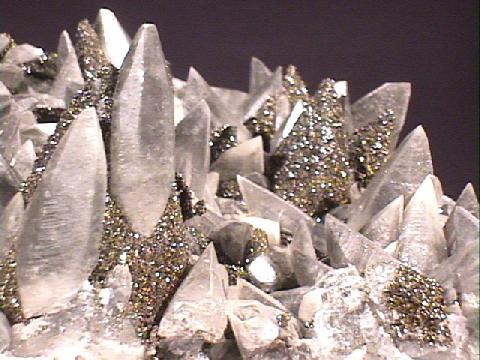

cal-132 ($145.00)
1100 foot level, 106 drift, Brushy Creek Mine, Reynolds County, Missouri, U.S.A.

CALCITE specimen cal-133
$ 26.00
$ 26.00
Dims: 2.4 x 1.9 x 0.7" (6.1 x 4.8 x 1.8 cm)
Wt: 1.23 oz. (35.0 g)
unknown
Many stubby, trigonal Calcites rest on the quartzite base of this flat hand specimen. These crystals do not exceed 0.1" (3 mm) in diameter or length and are in very good condition, showing little damage. Their trigonal form is good, and their luster is greasy. All are colorless, transparent and dimly clear. They are accompanied by many small, rounded nodules of what appear to be drusy psilomelane, and the quartzite base has been cut flat- thus the piece can be used in jewelry.

cal-133 ($ 26.00)
unknown

CALCITE specimen cal-135
$ 26.00
$ 26.00
Dims: 3.8 x 2.1 x 1.7" (9.5 x 5.3 x 4.3 cm)
Wt: 8.45 oz. (239.6 g)
Amax Mine, Reynolds County, Missouri, U.S.A.
Several small Calcite prisms extend from the dolomitic limestone base of this large hand specimen. Though two of the crystals are broken and incomplete, the rest are undamaged and in good condition, showing excellent trigonal form. Their color is a rather dull, creamy-yellow, and their luster is a dull pearly. All are dimly transparent. They are accompanied by hundreds of tiny, white dolomites, scores of small chalcopyrites and several marcasite nodules that have likely pseudomorphed into pyrite.

cal-135 ($ 26.00)
Amax Mine, Reynolds County, Missouri, U.S.A.

CALCITE specimen cal-138
$ 25.00
$ 25.00
Dims: 1.0 x 0.9 x 0.8" (2.5 x 2.3 x 2.0 cm)
Wt: 9 g w/ foam base
1100-foot level, 106 Drift, Brushy Creek Mine, Reynolds County, Missouri, U.S.A.
This thumbnail piece consists of a cluster of small, scalene "dogtooth" Calcites. These Calcites are in excellent condition - only one shows slight damage at its tip - and reach 1.1" (2.8 cm) in length. All have very good trigonal form and contain included layers of tiny marcasite crystals- a few of the crystals are coated by layers of marcasite that show red and green colors and a metallic luster. The rest show the gray color and pearly luster of the calcite. There is no host rock, and the piece is affixed inside a plastic thumbnail box.

cal-138 ($ 25.00)
1100-foot level, 106 Drift, Brushy Creek Mine, Reynolds County, Missouri, U.S.A.

CALCITE specimen cal-139
$ 25.00
$ 25.00
Dims:3.7x2.5x1.6" (9.4x6.4x4.1 cm)
Wt: 6.7oz. (191g)
Reynolds cty., Missouri
At least two dozen well-formed prismatic crystals of calcite form a crust on the top of this specimen. These crystals reach 0.7" (1.8cm) in length, and show excellent termination faces. This is an aesthetic specimen of a common mineral. The only damage to this specimen is around the edges, where it was broken away from the host rock.

cal-139 ($ 25.00)
Reynolds cty., Missouri

CALCITE specimen cal-140
$ 52.00
$ 52.00
Dims: 3.62x2.28x2.01" (9.2x5.8x5.1cm)
Wt: 9.40oz (266.0g)
Coahuila, Mexico
This hand specimen of calcite is not well-shaped, although it is crystalline showing cleavage planes. It is a rather unattractive off-white in color, with some mauve and a brown dusting. But under ultraviolet light, it comes alive. Under various wavelengths, it looks yellow or even pink, and under short-wave UV it glows a bright blue, a color which remains (briefly) after the light is turned off (it is phoshorescent).


cal-140 ($ 52.00)
Coahuila, Mexico

CALCITE specimen cal-141
$ 38.00
$ 38.00
Dims: 3.85x1.53x0.92" (9.78x3.88x2.32cm)
Wt: 3.62oz (102.4g)
Level 670, La Sirena mine, Guanajuato, Mexico
This specimen displays calcite crystals against a pyrite druze backdrop. The calcite is colorless and transparent, but a finely striated surface (somewhat reminiscent of a cat's tail in shape) obscures the interior and creates a slightly milky appearance. While the overall crystal is round in cross section, there are several small attached rhombic calcite crystals with are transparent and display a vitreous luster. The pyrite druze consists of tiny cubic crystals with a slightly irridescent blue appearance.


cal-141 ($ 38.00)
Level 670, La Sirena mine, Guanajuato, Mexico

CALCITE specimen cal-142
$ 30.00
$ 30.00
Dims: 3.77x1.82x1.09" (9.59x4.62x2.77cm)
Wt: 3.30oz (93.5g)
Hechi, Guangxi, China
This is a relatively unusual specimen of calcite, in that it's color is a lovely pale green and it is at least slightly transparent with good crystals that are relatively flat with definite striations. The color does vary a bit from crystal to crystal, and the striations and translucency gives these crystals a nearly silky luster.


cal-142 ($ 30.00)
Hechi, Guangxi, China